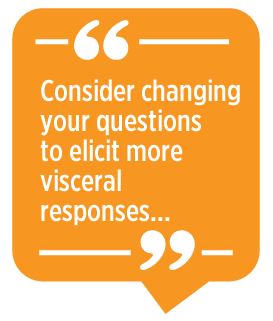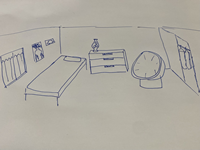|

As we start to prepare for our new semesters, many of us
have begun to reach into our toolbox of “Would you rather” questions, “Find
someone who” bingo sheets, and “Two Truths and a Lie” type activities. All of
these are great fun, and good ways to get your students comfortable with each
other, but as teachers we often have a hard time hearing any more than a couple
of responses at a time. Additionally, while encouraging students to speak up,
circling the room, and doing our best to monitor for language issues, we’re
lucky to remember one or two things about a handful of students by the end of
the first hour.
I’d never advocate for leaving the icebreakers
behind, but a number of teachers are recognizing the need to develop more
personal one-to-one relationships with their students (see these articles at Edutopia, teachthought.com,
and The
Education Trust), and the often quick shift from icebreakers to
classroom content may not leave much time for teachers to get the direct time
with students they need to build the foundations of a trusting relationship.
Luckily, there are lots of solutions to help us make deeper, more meaningful
connections with our students, and today we’ll discuss some of the many ways
you can use one simple tool to get you started building a stronger classroom environment.
Taking the Time
Before we get started, it’s worth reminding
ourselves of the old truism, “Students don’t care how much you know until they
know how much you care.” This maxim comes up in education circles all the time
for good reason! But in the hustle and bustle of the first weeks of school,
many of us sneak by with a smile and a few kind words, and then we often move
along to our next responsibility. Make no mistake, though: Your students can
tell the difference between a superficial greeting and taking the time to think
about them (yes, each of them!), hear what they have to say, respond to them,
and be vulnerable in your own sharing. So, as you look through the following
suggestions, I’d like to challenge you to make two promises to yourself and to
the class you have yet to meet:
-
I will complete my own responses to any activity
I ask my students to respond to, and I will let them see my responses before
asking them to send anything to me.
-
I will set aside the time I need before the
second class meeting to watch, read, or listen to every student’s response, and
I will respond to each of them privately and thoughtfully.
I recognize that this may add quite a lot of
time to your first days of work, but it will also set the tone for the whole
semester, and it will give students the opportunity to see that you are there
for them. So did you promise yourself? Great! Let’s get started!
Surveying Students Through Online Forms
Many teachers offer surveys at the beginning of the semester, but usually not
much comes of them. Some of us hand out paper forms where students can fill out
a few quick questions. Others have moved online to quickly collect basic
information. However, using simple online tools, like Google Forms or Microsoft
Forms, allows us to make far deeper connections than you might initially
imagine.
Text
Questions
Let’s start with the basics. Many of us know
that we can collect basic text answers through forms. But far fewer have
considered how to turn boring questions into real touch points. Of course, you
can ask questions like “Why are you studying here?” or “What’s your favorite
food?”, but consider changing the questions to elicit more visceral
responses:
- Share one way you hope that learning English can
improve your life.
- Describe in detail the best meal you’ve ever
had.
A simple change to the form of your question can be
the difference between “I answer this in every English class I ever join” and
“Oh, this teacher wants to know about me!”
 Links Links
The power of forms doesn’t end with just a lot of
text. Students can do so much more, but the easiest next step is asking them to
share links. One of my favorite uses for links is to ask students to share a
link to their favorite song on YouTube. You can listen to their favorite song
while reading the rest of their responses, and you can also add the song to a
class playlist. Students almost always forget that they shared the song with
you, so I like to start playing the playlist a few weeks later during class
breaks, and they’re often shocked to hear their favorite song playing over the
classroom speakers. As a bonus, you can follow up the request to link their
favorite song with a question about it. Again, surface level questions like
“Why do you like this song?” will usually come up with answers like “Good
rhythm,” or “She is cool,” but a question like “What memories come up when you
hear this song” will open up a treasure trove of personal connections.
In addition to music links, you can have your
students share links as far as your imagination takes you. Here are a few
possibilities that you can have them share; feel free to customize as you
see fit to match your population:
-
Wikipedia article: Favorite actress, athlete, artist, historical figure, and so on.
-
Funniest meme: This
could be in their language and they could try to explain why it’s so funny to
them.
-
Who should I follow on
Instagram or TikTok?: Again, follow up with questions, such as
asking about the best upload that content creator has made.
-
Most underrated
website: Perhaps a site you refer to on a regular basis, or something
that helps you be more productive.
-
Favorite app that isn’t social
media: Many phones let you see what apps you use most regularly,
and often times people are surprised at what comes up as most used.
Once you start breaking your form questions from
traditional questions to linkable resources, you can build a much stronger
understanding of what drives your students. Savvy readers will note that I
didn’t include questions about movies or TV shows. As much as I love movies
myself, I’ve noticed over the years that more and more students respond with “I
don’t watch movies/TV shows.” A sign of the times? Maybe. Regardless, I’ve
found they’re more likely to share content that is short and digestible, so
I’ve updated my questions to reflect that change.
Uploads
The ability to upload files directly into forms
means that students can send you any media—no need to get them logged into the
EdTech flavor of the month to record an introduction or snap a picture.
Whatever they can make, however they can make it, they can send it straight to
you: photos, videos, digital drawings, written documents, and so on; their
world is at your fingertips.
Keeping in mind that the goal is to get to know
them as people, not students, consider some of the following things you might
ask them to upload. As always, make sure you follow with a question that probes
at what makes the upload personal to them. I’ve added some potential follow-up
questions, but I encourage you to think of better ones!
-
A photo of your pet:
How would you describe its personality? Tell a story where it showed its
personality off.
-
A short video from your most recent
vacation: What is one thing you didn’t get to do while you were
there?
-
 A drawing of your childhood
bedroom: What were you most proud of in your room? (Note: I’m a
terrible artist, so showing off my own stick-figure drawings can set students
at ease for showing their own work.) A drawing of your childhood
bedroom: What were you most proud of in your room? (Note: I’m a
terrible artist, so showing off my own stick-figure drawings can set students
at ease for showing their own work.)
-
An audio recording of a place you
go to relax or have fun: (This can be ambient noises from a coffee
shop, birds chirping on their favorite hiking trail, a concert they went to
recently, or anywhere else.) If you could never go to this place again, what
would you tell people about it?
As you can see, once the ball starts rolling,
you’ll have a harder time editing and cutting questions than you will coming up
with them. And hey—you don’t have to have the perfect survey right away. You
can build it, adjust it, and improve it every semester.
To see an example online form with all of the
elements I discussed in this article, see this
one I created on Google Forms. Please feel free to reuse any of the
questions, or even the form itself.
The most important part of this process
is to take the time to enjoy their responses. Here is a chance to revel in each
student’s unique experience and to get to know them as more than just another
passing face, but as a person with an incredible history, dreams, and a
limitless future. With some simple tech and a dedication of a little time, you
can do more than just break the ice—you can crack the iceberg of the
student-teacher relationship.
Brent Warner is a
professor and cochair of the ESL department as well as cochair of the Online
Education Committee at Irvine Valley College in California. He’s an educational
technology enthusiast and cohost of the
DIESOL podcast, the only podcast with a specific focus on edtech and
innovation in ESL. He frequently presents on the crossroads of technology and
language learning, focusing on student engagement and developing learner
autonomy.
|